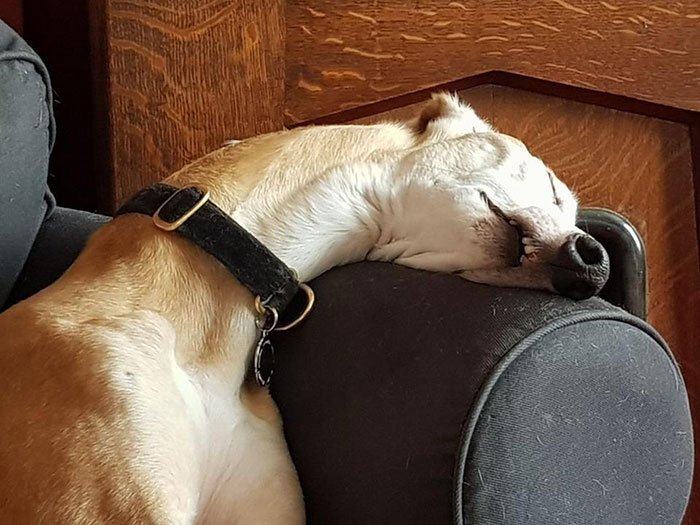Sleep plays an important role for all living beings when it comes to learning processes, relaxation, and processing. Our dogs are no exception. Our four-legged friends sometimes have the most unusual sleeping positions. In this article, you will find out what you should pay attention to in order to offer your four-legged friend the best possible rest and what the sleeping position of the dog can say about their nature.
Why good sleep is important for dogs

During sleep, the brain processes experienced and learned processes, events of the day, and body and mind draw new energy. Anyone who has ever suffered from lack of sleep knows how much it can put a strain on an organism. Therefore, good sleep is also important for dogs for their well-being and development. While humans need an average of eight hours of sleep a night, dogs need a lot more hours. Healthy adult dogs need around 17-20 hours of sleep a day, puppies and older or sick dogs should sleep up to 22 hours a day.
But this is easier said than done in everyday life. Due to their great fixation on us humans, many dogs often find it difficult to perceive their own needs and meet them. As a result, many dogs sleep too little because they are very busy paying attention to their people and wanting to be with them. It is therefore important for dog owners to lovingly support their dog in calming down and occasionally reminding them that sleep is a must. Especially very energetic dogs or dogs with fear of loss usually find it more difficult to relax than completely relaxed and balanced conspecifics.
In general, as a dog owner, you should actively give your dog the urgently needed rest breaks and encourage the dog when it goes to its sleeping or resting place itself. If possible, avoid waking the dog from sleep. In households with younger children in particular, care should be taken to ensure that the dog enjoys its well-deserved rest without being disturbed.
How do happy dogs sleep?

In general, there is no position that speaks particularly for or against a happy dog. Sleep should therefore always be evaluated along with the dog’s general behavior with an eye to quickly noticing a dog’s discomfort.
Dog sleeping position – A good place to sleep
In order to support the dog in its sleeping units, the sleeping place set up for it should meet a number of criteria. However, it is always important to keep in mind that dogs, like humans, are very individual in their sleeping behavior and can have different preferences. However, if you watch your dog carefully, you will quickly find out.
Most dogs like to be close to their pack, their human family. The sleeping place should therefore not be too far away from the usual place of residence of the people living in the household, but still offer enough rest. Passageways, such as the hallway, are therefore not so well suited as a place to sleep, since the dog will find it harder to rest here than in an inanimate corner of the room.
In addition, the environment should not be drafty and protected from direct sunlight to avoid hypothermia or overheating.
The size of the sleeping place depends of course on the size of the dog, in any case there should be enough space to stretch out. The correct hardness of the dog bed or the pillow on which the dog sleeps is also important for the health of the four-legged friend. A surface that is too hard can lead to pressure points and tension. However, if the dog sinks very deeply into its bed because the surface is too soft and does not provide any support, this is also unhealthy for the joints. Just as the right mattress is important for your own sleep, quality should be considered when choosing a dog bed.
How do dogs lie when they are relaxed?

A relaxed dog can lie in all sorts of positions, whether it’s on their stomach or their back. There is no universal sleeping position that speaks for a particularly relaxed dog. Anyone who knows their dog will quickly find out if the dog is restless or unhappy.
Sleeping position in dogs – an overview
Like us humans, dogs have individual preferences when it comes to their sleeping position. Behavioral researchers even put forward the thesis that the individual sleeping positions can say something about the nature and character of a dog. If your dog suddenly changes its usual sleeping position, this can always indicate that the animal may be unwell. If a change seems strange to you, don’t be afraid to consult your trusted veterinarian.
Side sleepers
Side sleepers usually lie on their side with their legs stretched out and are completely relaxed. This position usually indicates that the dog in question feels comfortable and safe in his environment and can let himself go completely.
The donut

Dogs that sleep in the donut position are usually curled up tightly, with their legs tucked under their body and often with their tails wrapped around themselves. In this sleeping position, the body’s heat is stored well and the dogs effectively keep themselves warm. They also protect sensitive parts of the body, such as the neck and abdomen, which attacking enemies would attack first. As a result, dogs that like to sleep in this position are said to be more likely to be anxious and insecure, and unable to completely let go of their protective wall even while they sleep. If your dog sleeps in this position, however, you don’t have to worry about whether he doesn’t feel safe with you. Some dogs are simply reassured by giving themselves warmth and feeling safe from their own touch.
Should Dogs Sleep on the Floor?
Dogs also usually like to be snuggly when they sleep, which is why the bare, usually cold floor does not make a very comfortable dog bed. For some dogs, however, a thin blanket is enough instead of a thick bed. Here it is important to pay attention to the individual preferences of the dog, which can be determined by trying out different options.
The superman

Superman is lying on his stomach, front and back legs casually stretched out. This position is often adopted when the dog is not in a deep sleep but is simply dozing and with one eye ready to quickly become active again.
The Stomach Sleeper

Similar to Superman, the stomach sleeper also lies on his stomach, but in this sleeping position the hind legs are usually pulled up and only the front legs are stretched out in front. Again, behavioral scientists tend to view dogs who like to sleep in this position as lively, alert, and agile — much like Superman.
The back sleeper

Sometimes the funniest-looking sleeping position a dog can adopt. From the outside, it seems at first glance that relaxed and restful sleep is not possible, but for many dogs, the back sleeper is the favorite sleeping position. The dog lies on its back, the legs fall relaxed on the chest/belly or to the side. A dog that assumes this pose usually feels completely safe as they are deliberately exposing vulnerable areas such as the sensitive abdomen. He, therefore, suspects no danger and is deeply relaxed. Usually, these dogs are very calm even when awake or are characterized by their great self-confidence.
Why is the dog under the covers?
Lying under a blanket gives some dogs a special feeling of security and safety.



























